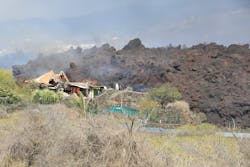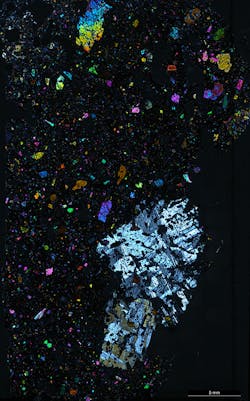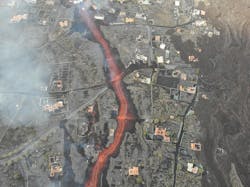Using laser ablation inductively coupled plasma quadruple mass spectrometry, researchers at the University of Queensland’s School of the Environment (Queensland, Australia) are producing more detailed data than ever before about what’s happening at the chemical level in volcano magma, a combination of liquid melt, gas, and crystals that can offer information about eruptions and lava flow (see video).
“The laser approach allows us to select only the erupted magmatic liquid and avoid the cargo transported to the surface, which can obscure geochemical information,” says Teresa Ubide, an associate professor of Igneous Petrology with the School of the Environment.
Understanding the chemistry of the magma, specifically just the magmatic liquid, is valuable because magma chemistry significantly influences eruption style and the physical properties of generated lava flows, including temperature and viscosity, which impact how far and at what speed lava flows can travel. “So, the chemistry of the magma is important to assess the evolution of the eruption and its potential hazards,” Ubide says.
The team’s laser ablation technique uses an inductively coupled plasma quadruple mass spectrometry instrument to measure the chemical composition of the material—in this case, lava—generated by the laser component. This approach provides more precise data about what’s happening chemically in the volcano magma; this is crucial to projecting patterns and changes in eruptions.
“Magmas reaching the surface of Earth are a mixture of the hot magmatic liquid and the fragments it transports from the guts of the volcano,” Ubide says. “The novelty of our approach is to apply the method to the analysis specifically of the magmatic liquid during eruptions.”
Why laser ablation?
Laser ablation is useful as a micro-sampling tool in research involving natural sciences because it allows users to select exactly what part of a biological sample to analyze at the chemical level. With conventional investigative approaches, an entire bulk sample must be analyzed.
Specifically, traditional chemical analysis methods look at entire volcanic rocks (cooled-down magma; see Fig. 1), Ubide explains, whereas the laser ablation inductively coupled plasma quadruple mass spectrometry approach allows the researchers to select only the parts of the rock that will offer the best information for a particular application.
There are naturally many crystals in volcano magma (which makes it look more like bunches of rocks), and its chemistry is difficult to observe. In their work, the Queensland team used an argon fluoride excimer laser—comprising noble gas and a halogen gas, which ultimately emits stimulated ultraviolet (UV) light in the 193 nm range—to blast the cooled-down liquid melt in the magma, also called the rock matrix, to remove surplus crystals (see Fig. 2). This technique, in turn, allowed them to measure only the magma’s chemical makeup.
The process required minimal sample preparation, Ubide says, so “it’s fast, which is important to provide timely information on the chemistry of erupted magma.”
Testing the method
Using the laser ablation inductively coupled plasma quadruple mass spectrometry approach, Ubide’s team has examined samples collected during the nearly three-month-long volcanic eruption on La Palma, the most northwesterly island of Spain’s Canary Islands, in 2021.
This eruption covered almost five square miles and discharged more than 5600 cubic feet of lava, causing extensive damage and posing dangers to residents (see Fig. 3). Being able to prevent or, at least, minimize such destruction and danger is a key goal of the Queensland team’s work. Gathering as much data as possible through live monitoring could ultimately provide early warnings.
Ubide notes that current monitoring approaches involving ground changes, such as earthquakes, and data relating to gases can offer information indirectly about what’s happening inside an active volcano. Information and data from the chemical level can provide more direct measurement and monitoring.
“Helping the monitoring and emergency management of future eruptions is our ultimate goal with this work,” Ubide says. “It is so important that the method is fast and versatile, and applicable to a wide range of eruption products.”
The team is now developing another method similar to their laser ablation technique to study volcanic ash, which can be dispersed more widely and collected with the help of local populations—citizen science—and enable a faster eruption response.



